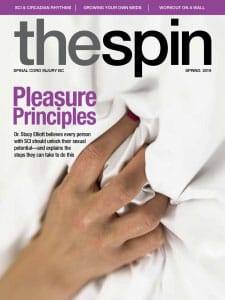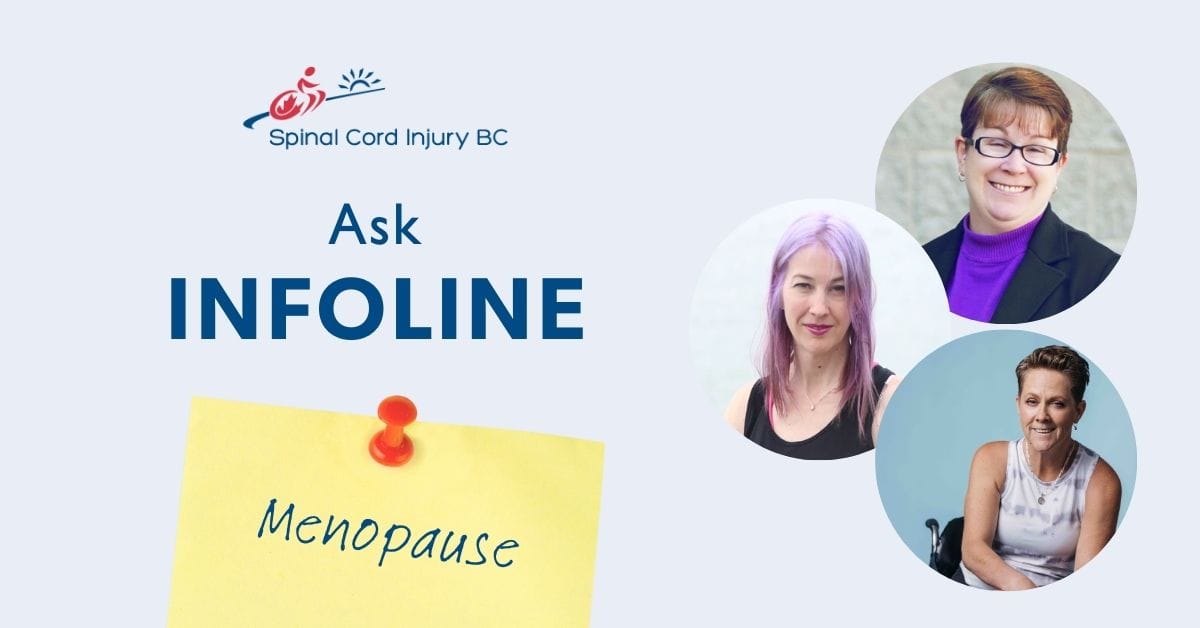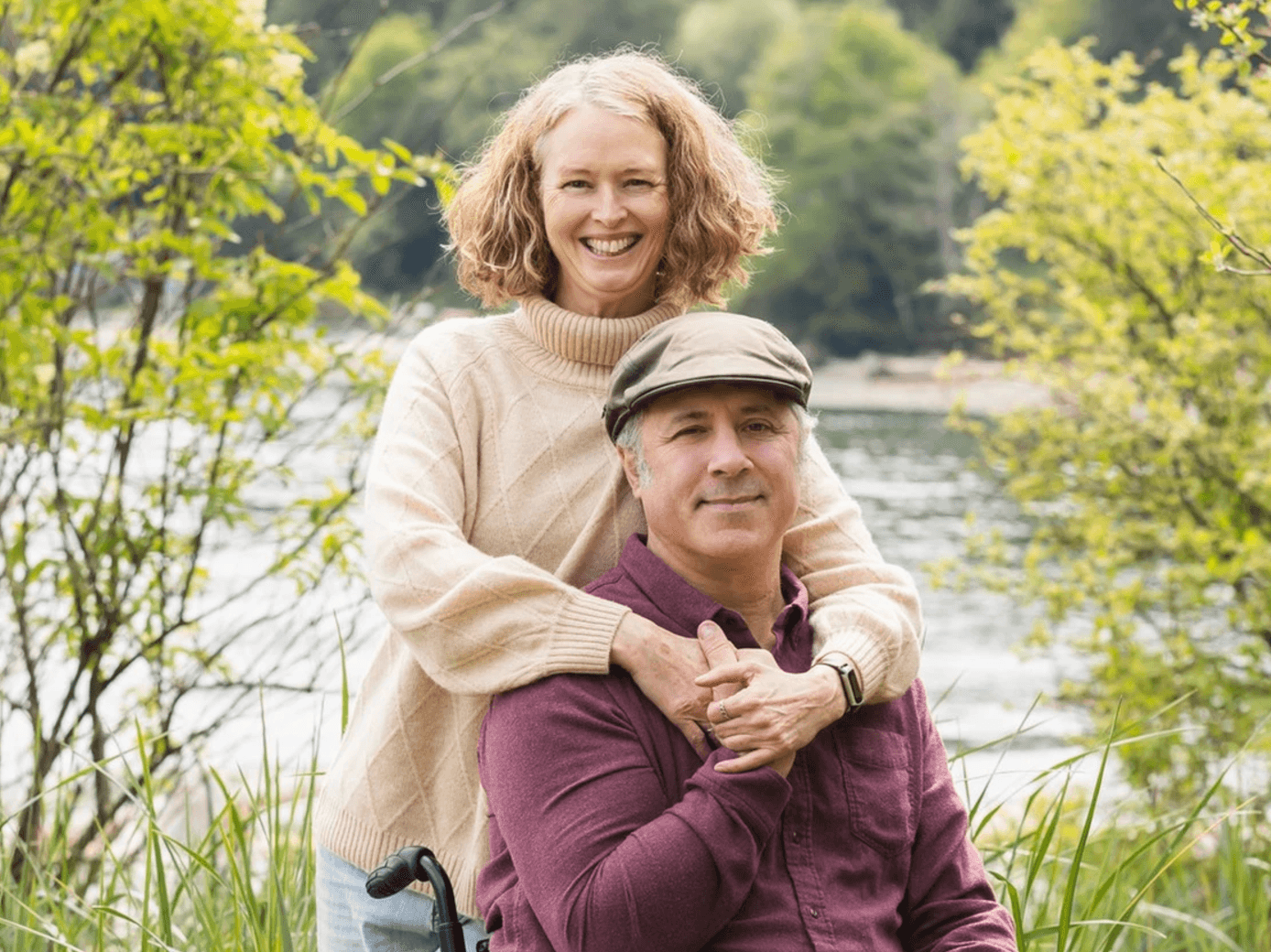
Sexuality is a given right. Even the World Health Organization says so. Having an SCI does not change that.
Many readers have no doubt heard ignorant assumptions about people with SCI being asexual or disinterested in sex, or have been on the receiving end of insensitive questions such as, “How do you do it?” But the fact is: sexuality is super important before and after SCI, and very possible!
Sex is healthy. Feeling that you’re a sexually whole person, and you can still experience sexual pleasure among the daily grind of pain, bladder, bowel and other secondary issues you face after SCI, is really important to your quality of life. In your own privacy or with a partner, you deserve to have a sexual life, if you want it.
The willingness to explore, the interference of pain or other SCI complications, the feelings of sexual self-esteem, the idea of readiness to be sexual in the path of rehabilitation and getting on with life—all of these will affect sexual desire. In general, sexual desire typically returns, and may not be changed from pre-injury.The bottom line is: you’re as sexual as you were before injury—it just may take some knowledge and perhaps a change in attitude to maximize your potential.
SEXUAL REHAB MATTERS
Sexual rehabilitation is one way of achieving your sexual potential. During SCI rehab, sexuality and fertility are often considered a low priority—sometimes they’re not discussed at all. Yet people living with SCI rank sexuality as one of their highest priorities in quality of life surveys.
For example, one survey of 681 persons living with SCI determined that sexuality was the second highest priority for people with quadriplegia, with only regaining arm and hand function being higher. And for paraplegics, sexuality was the top priority.
Given this, and considering many people acquire an SCI at a young age, sexual rehab should begin in acute care (depending on patient readiness) and continue as an outpatient.
In the Lower Mainland, this isn’t a problem, as we have the Sexual Health Rehabilitation Service (SHRS) at GF Strong and Vancouver General Hospital. This service focuses on self-esteem, confidence, relationships, positioning issues, erectile enhancement, pleasure, pregnancy and more. It’s also connected with The Vancouver Sperm Retrieval Clinic for those who wish to become biological fathers.
But not everyone lives in the Vancouver area, and a lot of readers don’t have easy access to this type of specialized rehabilitation expertise. That’s why I was keen to write this story for readers of The Spin who live in every corner of the province. The goal is to give an overview of sexuality and SCI that hopefully encourages you to explore and maximize your sexual potential, and provide knowledge and tools to begin.
More help is but a mouse-click away.
Want to know more about sexuality and SCI? Head to www.scisexualhealth.ca.
A collaborative resource created by Spinal Cord Injury BC and Vancouver Coastal Health’s Sexual Health Rehabilitation Service that covers virtually all aspects of SCI and sexuality—no subject is taboo.
In the spirit of Peer-to-Peer sharing, we urge you to get involved and explain what works—and what doesn’t—for you.
Need more information and support? Consider seeking a referral to the Sexual Health Rehabilitation Service, which offers specialist clinical services at Blusson Spinal Cord Centre at Vancouver General Hospital and GF Strong Rehabilitation Centre in Vancouver.
BRAIN POWER
What we’ve learned from our patients is that, while motor and sensory healing reaches a plateau where no more improvement can be expected (and vigilance for loss of function becomes a priority instead!) sexual recovery continues for years.
If you want to explore your sexuality on your own, try this body mapping exercise: In a shower or bath, or just lying or sitting quietly, take your hand (or someone else’s) or a feather and, with eyes closed, begin to explore, starting with your face, neck and ears. Continue down your whole body while thinking positive and erotic thoughts. What is the most sensitive? What has potential, if you relaxed into the moment and became mentally aroused, to feel like a sexual stimulus? What parts of your body are neutral or negative to touch? What parts are not a source of pleasure, and can be avoided in the future? With deep, slow breathing, staying in your head and not criticizing or judging yourself, try to elevate that sensual feeling in your head while the stroking continues. When you feel yourself getting higher, your breathing and heart rate may increase. If you’re stroking your genital area, you may even feel some increase in abdominal and lower body spasming. As long as you’re not developing a headache (a sign of autonomic dysreflexia), this is okay and completely normal!
Congratulate yourself on this small but newfound change. When you continue to practise this in the presence of mental sexual arousal, things will slowly start to change. In a way, it’s a form of mindfulness that allows acceptance of what your body has (versus what it doesn’t have), and you’re maximizing your body’s potential by tuning in.
If your mind is willing and accepting, repetitive positive feedback to the brain from areas other than those that may have been the jackpot before (i.e., your genitals, which you may no longer feel) can rewire the brain to interpret these new areas as sexual.
In other words, mapping areas of your body that bring pleasant sensations (it may be ears, neck, breast, the area of transition to injury, etc.) and combining touch with erotic thought can lead to those areas becoming responsive to sexual stimulation over time. That formerly non-sexual body part does not need to continue to feel nonsexual if you continue to stroke it and let your mind elevate into sexual arousal. It can turn into an erotic zone. But this takes a lot of practice.
Giving permission to explore oneself is critical after SCI, because sex after SCI will be different. Think back to rehab—do you remember exercises with your physio and occupational therapists? You might have been coached, but the rehabilitation itself was all you. It’s the same with sexual rehabilitation. You use your brain and envision your body as a source of electric energy and erotic feelings, this can be done by yourself or with a partner.
O: GOOD, BUT NOT EVERYTHING
That’s right: orgasm may not be the pillar of sexual gratification. Learning gratifying sexual arousal and enjoyment, and partners’ enjoyment, is the key to intimacy, whether an orgasm occurs or not.
That’s not to suggest an orgasm isn’t really nice.
About 50 percent of women and 40 percent of men (with or without ejaculation) can achieve it after SCI. The more incomplete your injury and the more genital sensation you have, the more chance you can relearn climax of sexual release from stimulation of genitals.
About 50 percent of women and 40 percent of men (with or without ejaculation) can achieve it after SCI. The more incomplete your injury and the more genital sensation you have, the more chance you can relearn climax of sexual release from stimulation of genitals.
Some people can morph mild to moderate autonomic dysreflexia into a feeling of high arousal and release without a typical orgasm or ejaculation. Some men, mainly those with incomplete injury, can experience orgasmic sensations with ejaculation—if they can ejaculate (another issue after SCI).
It may be possible women with SCI have a higher likelihood of reaching orgasm after injury than men, as they may have had more pre-injury experience with non-intercourse arousal than men.
But again, orgasm is not the only end game. Orgasm potential after SCI may come from non-genital sources, like Tantric sex practices, or orgasm when sleeping! Back we go to neuroplasticity, the brain’s ability to rewire itself.

IT’S NOT ALL FUN AND GAMES
While there are many wonderful benefits to being sexual, there are a few risks to keep in mind. The primary one is significant autonomic dysreflexia (AD). Those with injuries above T6 are most at risk, especially if they have complete injuries.
The typical AD symptoms of bad headache, sweating and impending doom are not always experienced, even when your blood pressure is very high, so saying you “feel fine” does not always mean you are fine. This is really important to remember, particularly for men attempting to ejaculate by using a vibrator—ideally, they should go to a clinic and have their blood pressure measured while attempting this. At the least, they should get a home blood pressure cuff and check it in the heat of the moment. The same goes for women with AD with high arousal or who use a vibrator.
While mild AD can sometimes lead to pleasant almost orgasmic sensations, higher levels of AD need to be avoided.
If AD occurs, stop sexual activity, sit up and put your feet down, if possible. There is a possibility of preventing AD with the use of medication prescribed by a physician familiar with SCI or your physiatrist.
When all is said and done, focusing on what remains, instead of what’s been lost, opens up a whole new world. Your brain is an amazing thing when it comes to sexuality and still remains the most important.
Click here to read Pleasure Principles: Part Two – looking at the nuances of partners and Peer support alongside pleasure.
About the Authors:
Dr. Stacy Elliott is a Sexual Medicine Physician. She is a Clinical Professor in the Departments of Psychiatry and Urologic Sciences at UBC and a Principal Investigator at ICORD. She is the Medical Director of the BC Centre of Sexual Medicine, Co-Director of the Vancouver Sperm Retrieval Clinic, and Physician Consultant to the GF Strong Sexual Health Rehabilitation Service.
Shea Hocaloski is a rehabilitation nurse and sexual health clinician, who also contributed to this article.
This article first appeared in our Spring 2019 issue of The Spin, alongside other stories including:
- Hit The Wall: Wallgym System
- Questionable Timing: Circadian Disruption and SCI
- Much More Than Coffee: South Fraser Active Living Group
- Grow Your Own: Growing Therapeutic Cannabis
- and more!
Read the full Spring 2019 Issue of The Spin online!




